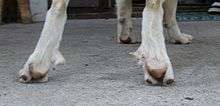Icelandic Sheepdog
 | |||||||||||||||||||||||||||
| Other names |
Icelandic Spitz Iceland Dog Íslenskur fjárhundur Islandsk Fårehund Friaar Dog Canis Islandicus | ||||||||||||||||||||||||||
|---|---|---|---|---|---|---|---|---|---|---|---|---|---|---|---|---|---|---|---|---|---|---|---|---|---|---|---|
| Origin | Iceland | ||||||||||||||||||||||||||
| |||||||||||||||||||||||||||
| |||||||||||||||||||||||||||
| Domestic dog (Canis lupus familiaris) | |||||||||||||||||||||||||||
The Icelandic Sheepdog is a breed of dog of spitz type originating from the dogs brought to Iceland by the Vikings. It is of similar type to the Norwegian Buhund, the Shetland Sheepdog, and the Welsh Corgi. They are commonly used to herd sheep in the Icelandic countryside.
Appearance
These are the current breed standards:
- Neck: moderately long, muscular, arched, carried high
- Back: level, muscular, strong
- Chest: long, deep, well sprung; reaches its elbow
- Belly: only a slight tuck upwards
- Tail: high-set, curled, touching back
- Forequarters: straight, parallel, strong fore legs
- Forefeet: oval-shaped toes, arched, tight, with well-developed pads
- Shoulders: oblique, muscular
- Hind legs: one or often two dew claws on each leg
- Gait: displays endurance and agility, driving action, covers ground effortlessly
- Head: strongly built, close-fitting skin, skull slightly longer than muzzle making it look triangular from side or above
- Nose: black, or dark brown in lighter-color breeds
- Muzzle: nasal bridge straight, slightly shorter than skull, tapers evenly towards nose to form triangle
- Lips: black, close-fitting, sometimes partially pink
- Bite: scissor
- Cheeks: flat
- Eyes: medium, almond-shaped, brown, eye-rims are black
- Ears: erect, medium in size, triangular, very mobile as they move in sensitivity with dog's moods, very sensitive to noise
- Height: male: 46 cm female: 42 cm
- Color: tan, reddish-brown, chocolate, grey, black, with white as a required prominent color
- Appearance from side: rectangular, length from shoulder to base of tail is greater than height at withers
- Depth of chest: equal to length of fore leg
- Coat:: two types - long and short, both thick and waterproof[1]
Temperament
Icelandic Sheepdogs are tough and energetic. Hardy and agile, they are extremely useful for herding and driving livestock or finding lost sheep. However, the dogs are not known for hunting. They are very alert and always give visitors an enthusiastic welcome, without being aggressive. Friendly and cheerful, the Icelandic Sheepdog is inquisitive, playful, and unafraid. They generally get along well with children, as well as other pets.
Activities
Icelandic Sheepdogs can compete in dog agility trials, obedience, rally obedience, showmanship, flyball, tracking, and herding events. Herding instincts and trainability can be measured at noncompetitive herding tests. Icelandic Sheepdogs that exhibit basic herding instincts can be trained to compete in herding trials.[3]
History
The Icelandic Sheepdog very much resembles dogs found in graves in Denmark and Sweden from about 8000 BC. Dog imports to Iceland were limited and from 1901 even forbidden.
In 1650, Sir Thomas Brown wrote, "To England there are sometimes exported from Iceland ... a type of dog resembling a fox ... Shepherds in England are eager to acquire them!"
Plague and canine distemper destroyed over 75% of the breed in the late 19th century, leading to a ban on the importation of dogs to Iceland. The purebred Icelandic Sheepdog was again bordering extinction in the late 20th century and in 1969, the Icelandic Dog Breeder Association (HRFÍ)[5] was established to preserve the breed, among other aims.
The Icelandic Sheepdog gained AKC recognition in June 2010, alongside the Leonberger and the Cane Corso.[6]
Miscellaneous
The breed is sometimes denoted in Latin as canis islandicus, though it is a breed and not a species.

As the name implies, it is a sheep dog, but is also used as a watch dog and general working dog. When herding, the Icelandic Sheepdogs were not mainly used to take the sheep from one point to another, but to prevent animals from straying. Additionally, the dogs were in charge of herding horses and other animals, as well. When herding failed, the dogs drove the animals by barking. Thus, they tend to bark when they want something, although this behaviour can be controlled by training.
In the Icelandic landscape, sheep often get lost and it has historically been the dog's job to find them and return them to the herd. They are, therefore, used to working on their own and to figuring things out for themselves, so owners have to beware lest they learn things they should not. As a watch dog, their main task was to alert the inhabitants when somebody was coming, so these dogs tend to bark a lot when they see people approaching.
The Icelandic Sheepdog is very loyal and wants to be around its family constantly. It follows its owner everywhere. Unlike most working dogs, these calm down when indoors and happily lie down at their master's feet.
References
- 1 2 "Icelandic Sheepdog Dog Breed Information". American Kennel Club. Retrieved 2015-09-17.
- 1 2 "Icelandic Sheepdog" (PDF). FCI. Retrieved 27 February 2015.
- ↑ Hartnagle-Taylor, Jeanne Joy; Taylor, Ty (2010). Stockdog Savvy. Alpine Publications. ISBN 978-1-57779-106-5.
- ↑ Mason, Walter, Esplin (1867). Dogs of all nations (1915). Retrieved 24 November 2010.
- ↑ "HRFÍ". hrfi.is.
- ↑ "AKC Welcomes the Cane Corso, Icelandic sheepdog and Leonberger". akc.org.
External links
| Wikimedia Commons has media related to Islenskur Fjárhundur. |
- Icelandic Sheepdog at Curlie (based on DMOZ)